SBM4202: Australian Broadcasting Corporation Case Study Analysis
VerifiedAdded on 2023/02/01
|18
|3692
|59
Case Study
AI Summary
This case study examines the Information Systems (IS) strategy of the Australian Broadcasting Corporation (ABC). The report begins with an executive summary highlighting the importance of IS/IT implementation for business innovation and productivity. It includes a company profile, product selection (telecommunication infrastructure), and an overview of the evolution of ABC's IS/IT strategy, which is presented in five stages: minicomputer computing, personal computers, client/server networks, enterprise computing, and mobile/cloud computing. The study identifies major challenges faced by ABC, such as financial and risk management, and presents a recent scenario involving a AUD$20 million contract requiring an enhanced IT management system. The report details a step-by-step approach including SWOT analysis, examination, and the role of IS/IT in the contemporary environment to reduce travel and costs. It also outlines an operational strategy and an implementation plan, including a monitoring plan for the Project Management Information System (PMIS). The case study concludes with recommendations for future IS/IT strategies.
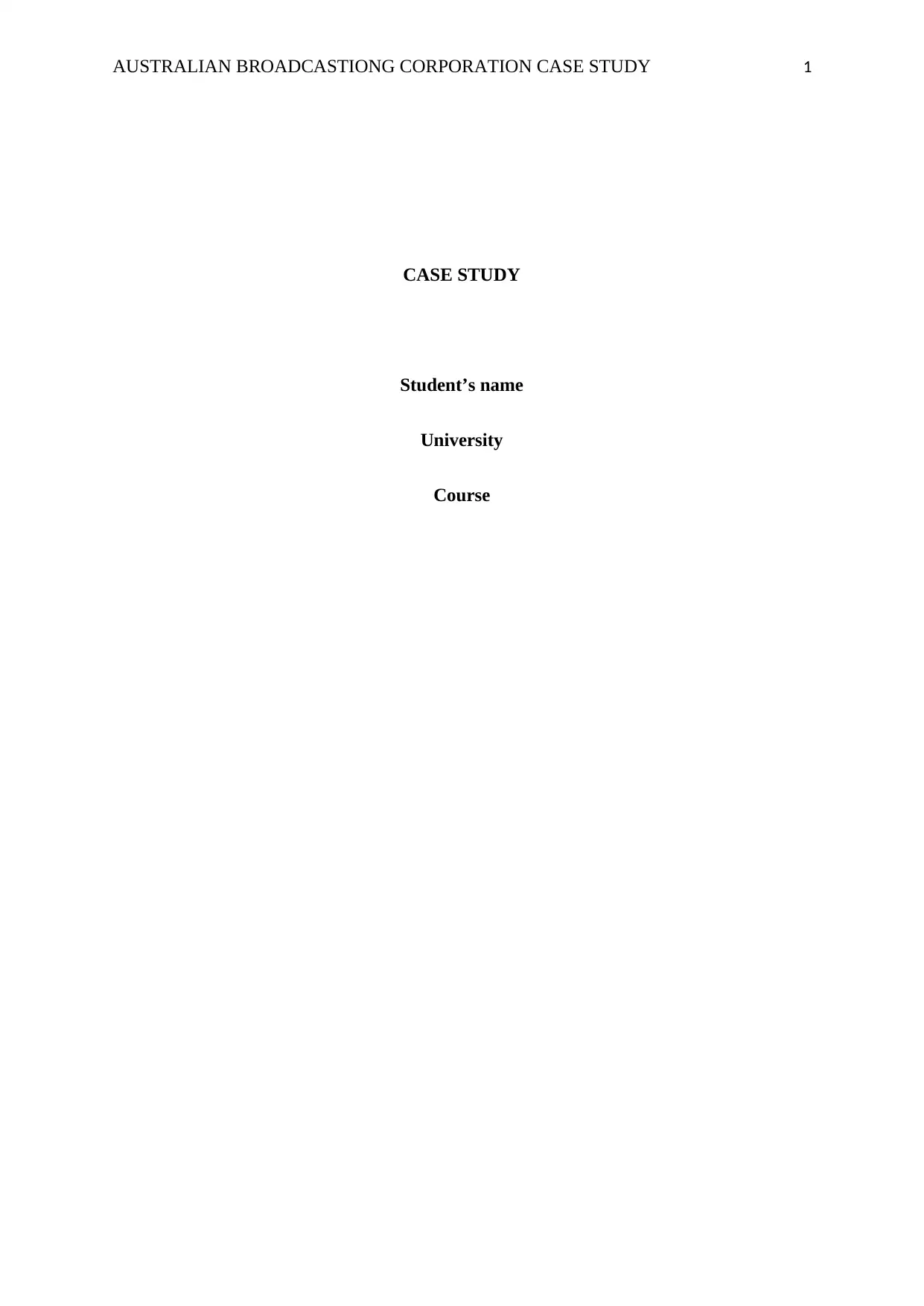
AUSTRALIAN BROADCASTIONG CORPORATION CASE STUDY 1
CASE STUDY
Student’s name
University
Course
CASE STUDY
Student’s name
University
Course
Paraphrase This Document
Need a fresh take? Get an instant paraphrase of this document with our AI Paraphraser
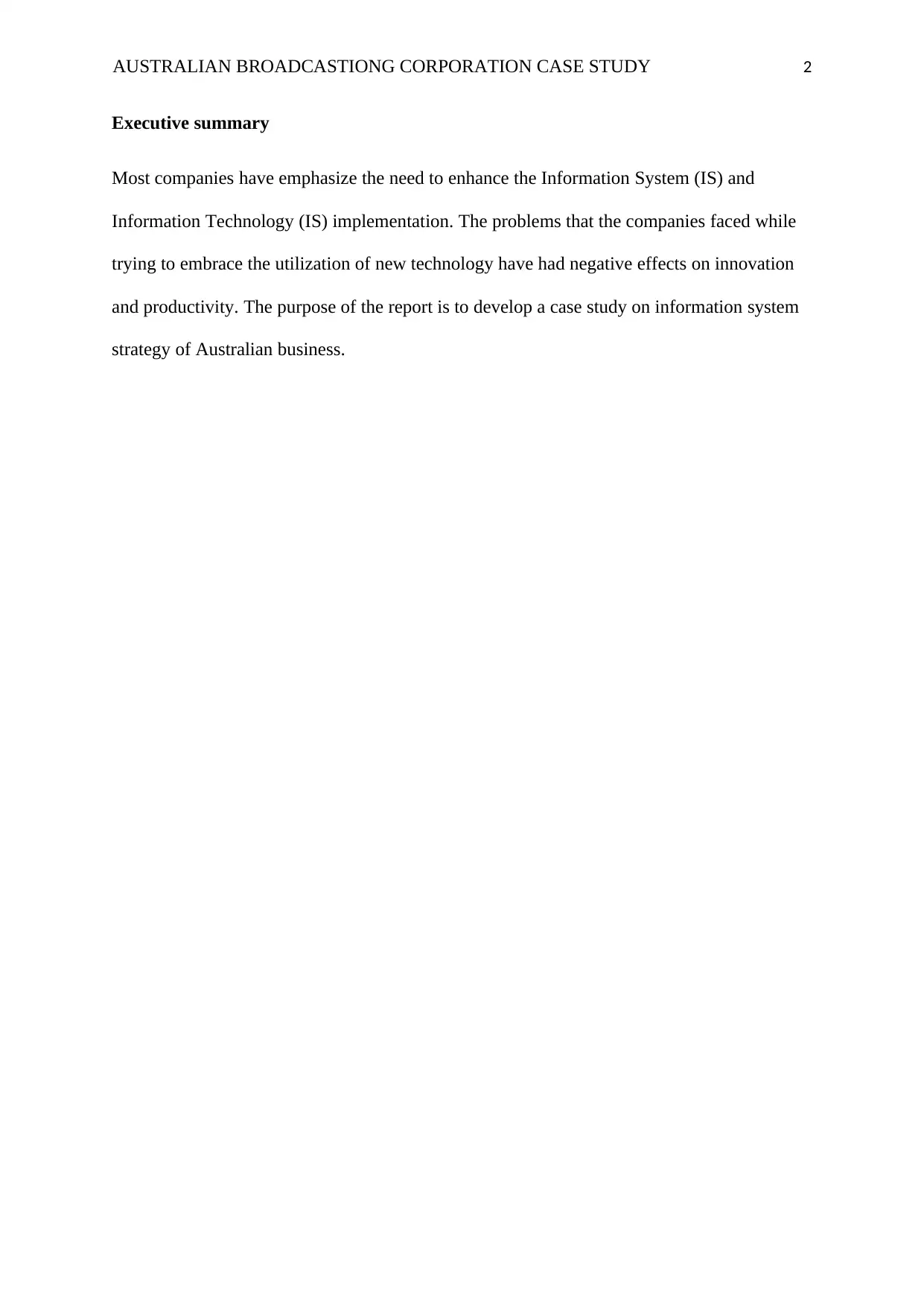
AUSTRALIAN BROADCASTIONG CORPORATION CASE STUDY 2
Executive summary
Most companies have emphasize the need to enhance the Information System (IS) and
Information Technology (IS) implementation. The problems that the companies faced while
trying to embrace the utilization of new technology have had negative effects on innovation
and productivity. The purpose of the report is to develop a case study on information system
strategy of Australian business.
Executive summary
Most companies have emphasize the need to enhance the Information System (IS) and
Information Technology (IS) implementation. The problems that the companies faced while
trying to embrace the utilization of new technology have had negative effects on innovation
and productivity. The purpose of the report is to develop a case study on information system
strategy of Australian business.
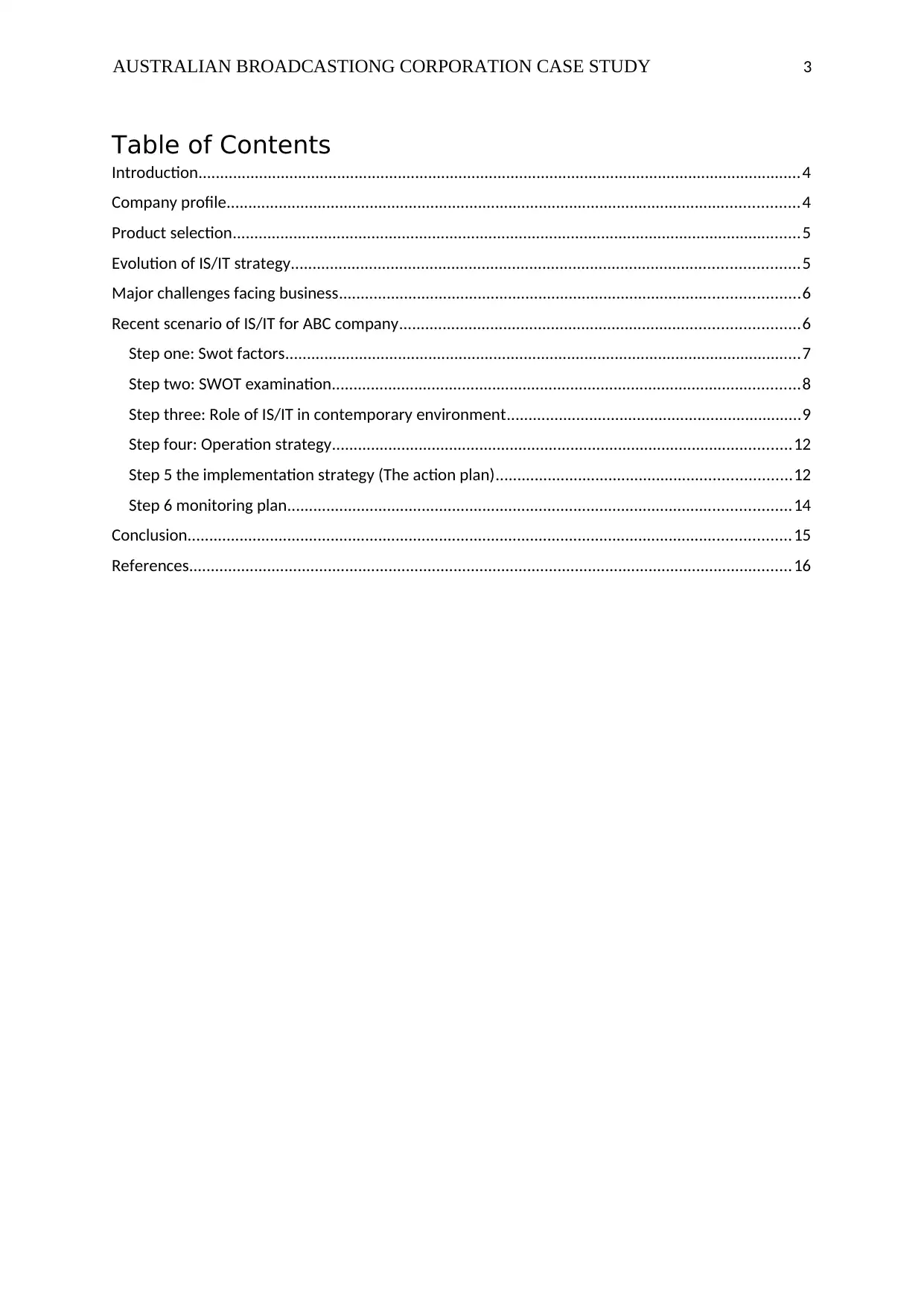
AUSTRALIAN BROADCASTIONG CORPORATION CASE STUDY 3
Table of Contents
Introduction...........................................................................................................................................4
Company profile....................................................................................................................................4
Product selection...................................................................................................................................5
Evolution of IS/IT strategy.....................................................................................................................5
Major challenges facing business..........................................................................................................6
Recent scenario of IS/IT for ABC company............................................................................................6
Step one: Swot factors.......................................................................................................................7
Step two: SWOT examination............................................................................................................8
Step three: Role of IS/IT in contemporary environment....................................................................9
Step four: Operation strategy..........................................................................................................12
Step 5 the implementation strategy (The action plan)....................................................................12
Step 6 monitoring plan....................................................................................................................14
Conclusion...........................................................................................................................................15
References...........................................................................................................................................16
Table of Contents
Introduction...........................................................................................................................................4
Company profile....................................................................................................................................4
Product selection...................................................................................................................................5
Evolution of IS/IT strategy.....................................................................................................................5
Major challenges facing business..........................................................................................................6
Recent scenario of IS/IT for ABC company............................................................................................6
Step one: Swot factors.......................................................................................................................7
Step two: SWOT examination............................................................................................................8
Step three: Role of IS/IT in contemporary environment....................................................................9
Step four: Operation strategy..........................................................................................................12
Step 5 the implementation strategy (The action plan)....................................................................12
Step 6 monitoring plan....................................................................................................................14
Conclusion...........................................................................................................................................15
References...........................................................................................................................................16
⊘ This is a preview!⊘
Do you want full access?
Subscribe today to unlock all pages.

Trusted by 1+ million students worldwide
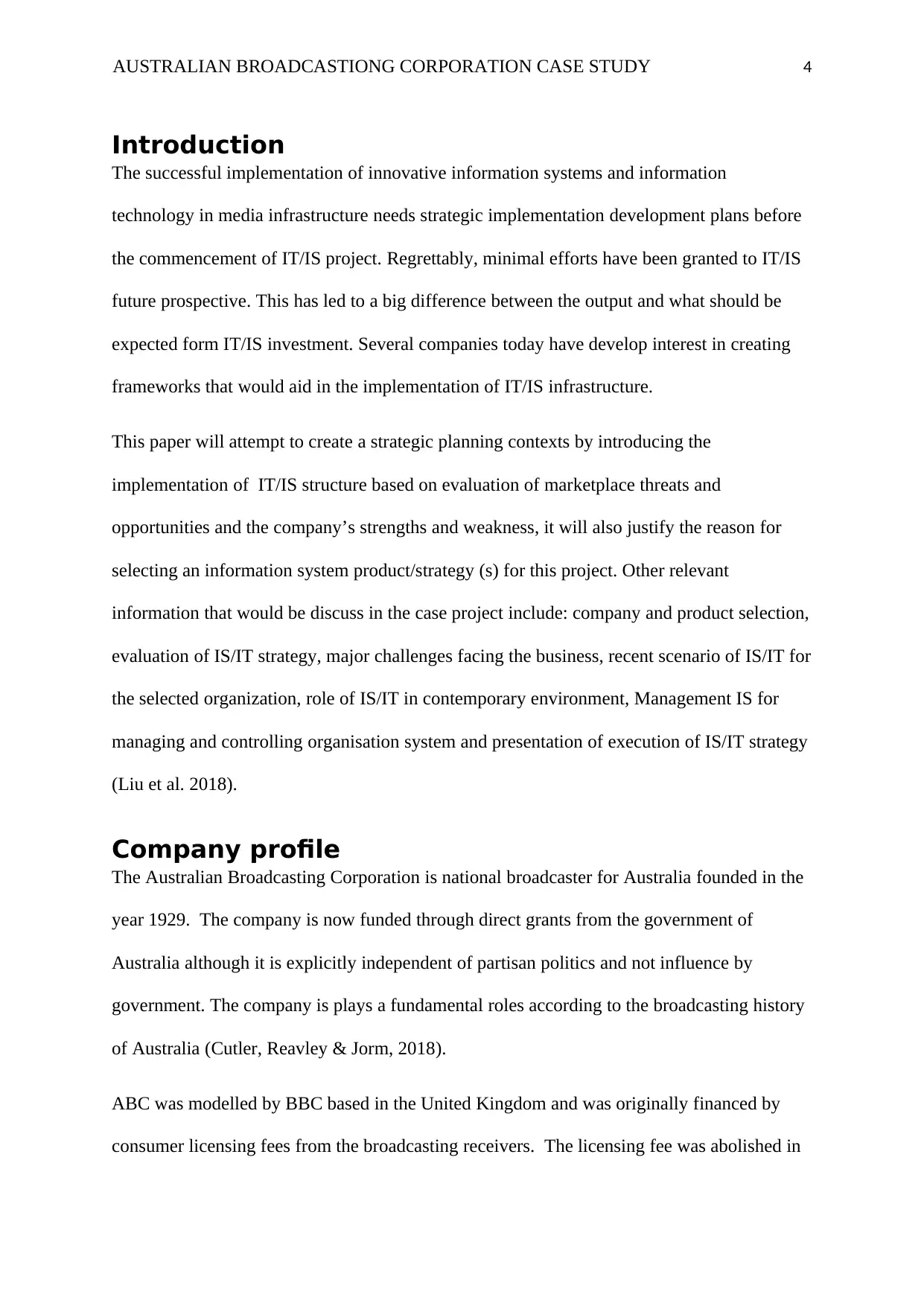
AUSTRALIAN BROADCASTIONG CORPORATION CASE STUDY 4
Introduction
The successful implementation of innovative information systems and information
technology in media infrastructure needs strategic implementation development plans before
the commencement of IT/IS project. Regrettably, minimal efforts have been granted to IT/IS
future prospective. This has led to a big difference between the output and what should be
expected form IT/IS investment. Several companies today have develop interest in creating
frameworks that would aid in the implementation of IT/IS infrastructure.
This paper will attempt to create a strategic planning contexts by introducing the
implementation of IT/IS structure based on evaluation of marketplace threats and
opportunities and the company’s strengths and weakness, it will also justify the reason for
selecting an information system product/strategy (s) for this project. Other relevant
information that would be discuss in the case project include: company and product selection,
evaluation of IS/IT strategy, major challenges facing the business, recent scenario of IS/IT for
the selected organization, role of IS/IT in contemporary environment, Management IS for
managing and controlling organisation system and presentation of execution of IS/IT strategy
(Liu et al. 2018).
Company profile
The Australian Broadcasting Corporation is national broadcaster for Australia founded in the
year 1929. The company is now funded through direct grants from the government of
Australia although it is explicitly independent of partisan politics and not influence by
government. The company is plays a fundamental roles according to the broadcasting history
of Australia (Cutler, Reavley & Jorm, 2018).
ABC was modelled by BBC based in the United Kingdom and was originally financed by
consumer licensing fees from the broadcasting receivers. The licensing fee was abolished in
Introduction
The successful implementation of innovative information systems and information
technology in media infrastructure needs strategic implementation development plans before
the commencement of IT/IS project. Regrettably, minimal efforts have been granted to IT/IS
future prospective. This has led to a big difference between the output and what should be
expected form IT/IS investment. Several companies today have develop interest in creating
frameworks that would aid in the implementation of IT/IS infrastructure.
This paper will attempt to create a strategic planning contexts by introducing the
implementation of IT/IS structure based on evaluation of marketplace threats and
opportunities and the company’s strengths and weakness, it will also justify the reason for
selecting an information system product/strategy (s) for this project. Other relevant
information that would be discuss in the case project include: company and product selection,
evaluation of IS/IT strategy, major challenges facing the business, recent scenario of IS/IT for
the selected organization, role of IS/IT in contemporary environment, Management IS for
managing and controlling organisation system and presentation of execution of IS/IT strategy
(Liu et al. 2018).
Company profile
The Australian Broadcasting Corporation is national broadcaster for Australia founded in the
year 1929. The company is now funded through direct grants from the government of
Australia although it is explicitly independent of partisan politics and not influence by
government. The company is plays a fundamental roles according to the broadcasting history
of Australia (Cutler, Reavley & Jorm, 2018).
ABC was modelled by BBC based in the United Kingdom and was originally financed by
consumer licensing fees from the broadcasting receivers. The licensing fee was abolished in
Paraphrase This Document
Need a fresh take? Get an instant paraphrase of this document with our AI Paraphraser
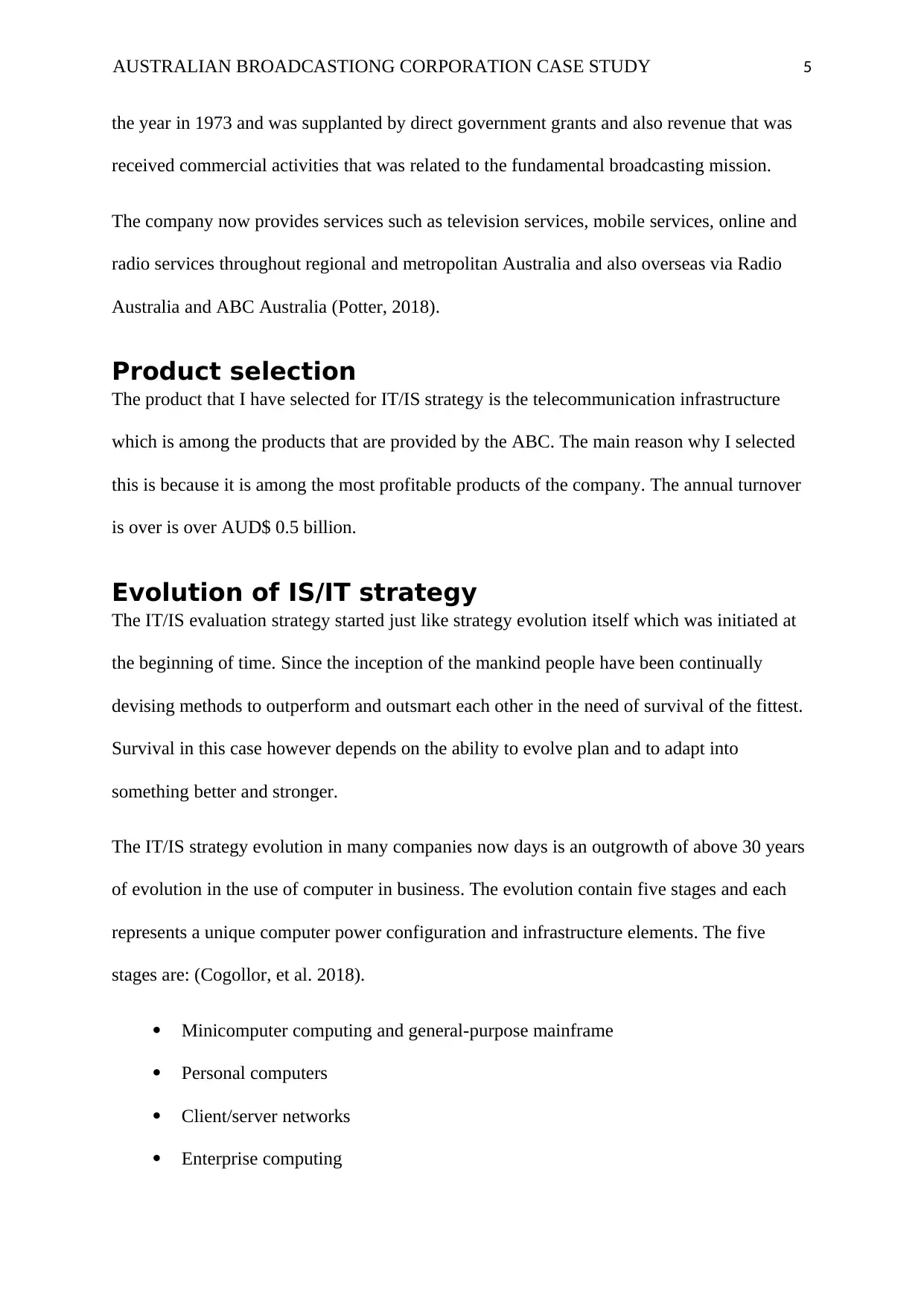
AUSTRALIAN BROADCASTIONG CORPORATION CASE STUDY 5
the year in 1973 and was supplanted by direct government grants and also revenue that was
received commercial activities that was related to the fundamental broadcasting mission.
The company now provides services such as television services, mobile services, online and
radio services throughout regional and metropolitan Australia and also overseas via Radio
Australia and ABC Australia (Potter, 2018).
Product selection
The product that I have selected for IT/IS strategy is the telecommunication infrastructure
which is among the products that are provided by the ABC. The main reason why I selected
this is because it is among the most profitable products of the company. The annual turnover
is over is over AUD$ 0.5 billion.
Evolution of IS/IT strategy
The IT/IS evaluation strategy started just like strategy evolution itself which was initiated at
the beginning of time. Since the inception of the mankind people have been continually
devising methods to outperform and outsmart each other in the need of survival of the fittest.
Survival in this case however depends on the ability to evolve plan and to adapt into
something better and stronger.
The IT/IS strategy evolution in many companies now days is an outgrowth of above 30 years
of evolution in the use of computer in business. The evolution contain five stages and each
represents a unique computer power configuration and infrastructure elements. The five
stages are: (Cogollor, et al. 2018).
Minicomputer computing and general-purpose mainframe
Personal computers
Client/server networks
Enterprise computing
the year in 1973 and was supplanted by direct government grants and also revenue that was
received commercial activities that was related to the fundamental broadcasting mission.
The company now provides services such as television services, mobile services, online and
radio services throughout regional and metropolitan Australia and also overseas via Radio
Australia and ABC Australia (Potter, 2018).
Product selection
The product that I have selected for IT/IS strategy is the telecommunication infrastructure
which is among the products that are provided by the ABC. The main reason why I selected
this is because it is among the most profitable products of the company. The annual turnover
is over is over AUD$ 0.5 billion.
Evolution of IS/IT strategy
The IT/IS evaluation strategy started just like strategy evolution itself which was initiated at
the beginning of time. Since the inception of the mankind people have been continually
devising methods to outperform and outsmart each other in the need of survival of the fittest.
Survival in this case however depends on the ability to evolve plan and to adapt into
something better and stronger.
The IT/IS strategy evolution in many companies now days is an outgrowth of above 30 years
of evolution in the use of computer in business. The evolution contain five stages and each
represents a unique computer power configuration and infrastructure elements. The five
stages are: (Cogollor, et al. 2018).
Minicomputer computing and general-purpose mainframe
Personal computers
Client/server networks
Enterprise computing
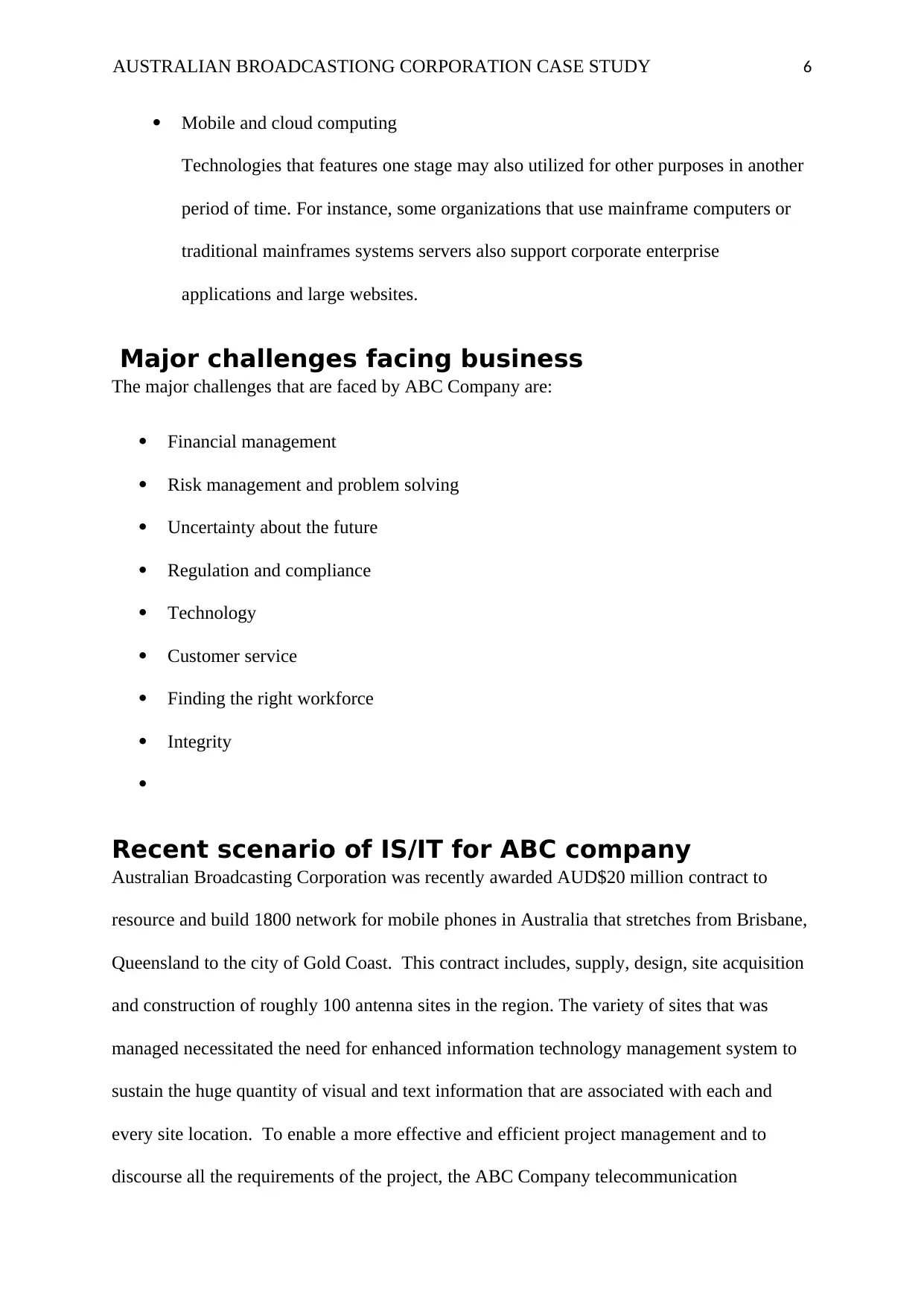
AUSTRALIAN BROADCASTIONG CORPORATION CASE STUDY 6
Mobile and cloud computing
Technologies that features one stage may also utilized for other purposes in another
period of time. For instance, some organizations that use mainframe computers or
traditional mainframes systems servers also support corporate enterprise
applications and large websites.
Major challenges facing business
The major challenges that are faced by ABC Company are:
Financial management
Risk management and problem solving
Uncertainty about the future
Regulation and compliance
Technology
Customer service
Finding the right workforce
Integrity
Recent scenario of IS/IT for ABC company
Australian Broadcasting Corporation was recently awarded AUD$20 million contract to
resource and build 1800 network for mobile phones in Australia that stretches from Brisbane,
Queensland to the city of Gold Coast. This contract includes, supply, design, site acquisition
and construction of roughly 100 antenna sites in the region. The variety of sites that was
managed necessitated the need for enhanced information technology management system to
sustain the huge quantity of visual and text information that are associated with each and
every site location. To enable a more effective and efficient project management and to
discourse all the requirements of the project, the ABC Company telecommunication
Mobile and cloud computing
Technologies that features one stage may also utilized for other purposes in another
period of time. For instance, some organizations that use mainframe computers or
traditional mainframes systems servers also support corporate enterprise
applications and large websites.
Major challenges facing business
The major challenges that are faced by ABC Company are:
Financial management
Risk management and problem solving
Uncertainty about the future
Regulation and compliance
Technology
Customer service
Finding the right workforce
Integrity
Recent scenario of IS/IT for ABC company
Australian Broadcasting Corporation was recently awarded AUD$20 million contract to
resource and build 1800 network for mobile phones in Australia that stretches from Brisbane,
Queensland to the city of Gold Coast. This contract includes, supply, design, site acquisition
and construction of roughly 100 antenna sites in the region. The variety of sites that was
managed necessitated the need for enhanced information technology management system to
sustain the huge quantity of visual and text information that are associated with each and
every site location. To enable a more effective and efficient project management and to
discourse all the requirements of the project, the ABC Company telecommunication
⊘ This is a preview!⊘
Do you want full access?
Subscribe today to unlock all pages.

Trusted by 1+ million students worldwide
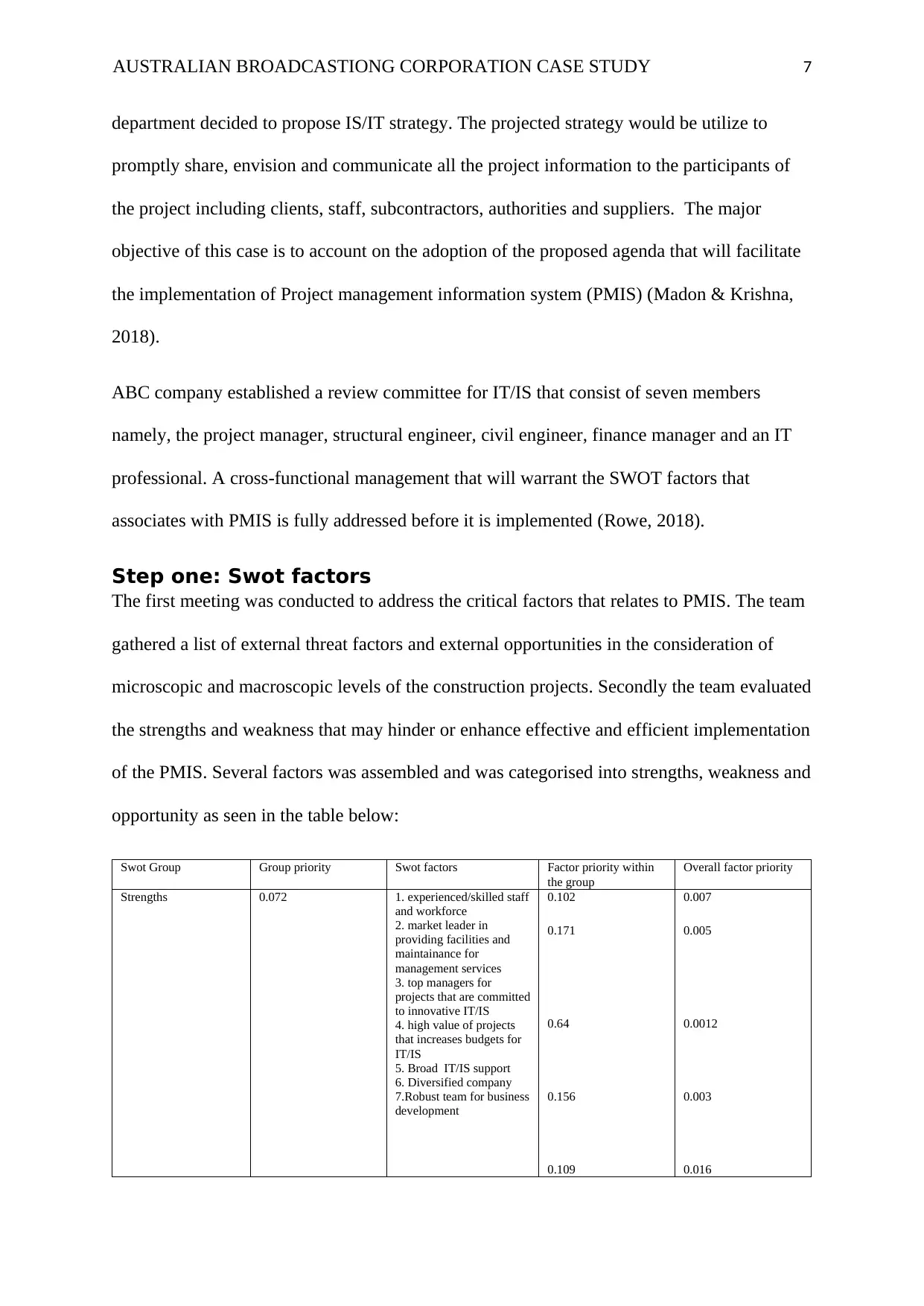
AUSTRALIAN BROADCASTIONG CORPORATION CASE STUDY 7
department decided to propose IS/IT strategy. The projected strategy would be utilize to
promptly share, envision and communicate all the project information to the participants of
the project including clients, staff, subcontractors, authorities and suppliers. The major
objective of this case is to account on the adoption of the proposed agenda that will facilitate
the implementation of Project management information system (PMIS) (Madon & Krishna,
2018).
ABC company established a review committee for IT/IS that consist of seven members
namely, the project manager, structural engineer, civil engineer, finance manager and an IT
professional. A cross-functional management that will warrant the SWOT factors that
associates with PMIS is fully addressed before it is implemented (Rowe, 2018).
Step one: Swot factors
The first meeting was conducted to address the critical factors that relates to PMIS. The team
gathered a list of external threat factors and external opportunities in the consideration of
microscopic and macroscopic levels of the construction projects. Secondly the team evaluated
the strengths and weakness that may hinder or enhance effective and efficient implementation
of the PMIS. Several factors was assembled and was categorised into strengths, weakness and
opportunity as seen in the table below:
Swot Group Group priority Swot factors Factor priority within
the group
Overall factor priority
Strengths 0.072 1. experienced/skilled staff
and workforce
2. market leader in
providing facilities and
maintainance for
management services
3. top managers for
projects that are committed
to innovative IT/IS
4. high value of projects
that increases budgets for
IT/IS
5. Broad IT/IS support
6. Diversified company
7.Robust team for business
development
0.102
0.171
0.64
0.156
0.109
0.007
0.005
0.0012
0.003
0.016
department decided to propose IS/IT strategy. The projected strategy would be utilize to
promptly share, envision and communicate all the project information to the participants of
the project including clients, staff, subcontractors, authorities and suppliers. The major
objective of this case is to account on the adoption of the proposed agenda that will facilitate
the implementation of Project management information system (PMIS) (Madon & Krishna,
2018).
ABC company established a review committee for IT/IS that consist of seven members
namely, the project manager, structural engineer, civil engineer, finance manager and an IT
professional. A cross-functional management that will warrant the SWOT factors that
associates with PMIS is fully addressed before it is implemented (Rowe, 2018).
Step one: Swot factors
The first meeting was conducted to address the critical factors that relates to PMIS. The team
gathered a list of external threat factors and external opportunities in the consideration of
microscopic and macroscopic levels of the construction projects. Secondly the team evaluated
the strengths and weakness that may hinder or enhance effective and efficient implementation
of the PMIS. Several factors was assembled and was categorised into strengths, weakness and
opportunity as seen in the table below:
Swot Group Group priority Swot factors Factor priority within
the group
Overall factor priority
Strengths 0.072 1. experienced/skilled staff
and workforce
2. market leader in
providing facilities and
maintainance for
management services
3. top managers for
projects that are committed
to innovative IT/IS
4. high value of projects
that increases budgets for
IT/IS
5. Broad IT/IS support
6. Diversified company
7.Robust team for business
development
0.102
0.171
0.64
0.156
0.109
0.007
0.005
0.0012
0.003
0.016
Paraphrase This Document
Need a fresh take? Get an instant paraphrase of this document with our AI Paraphraser
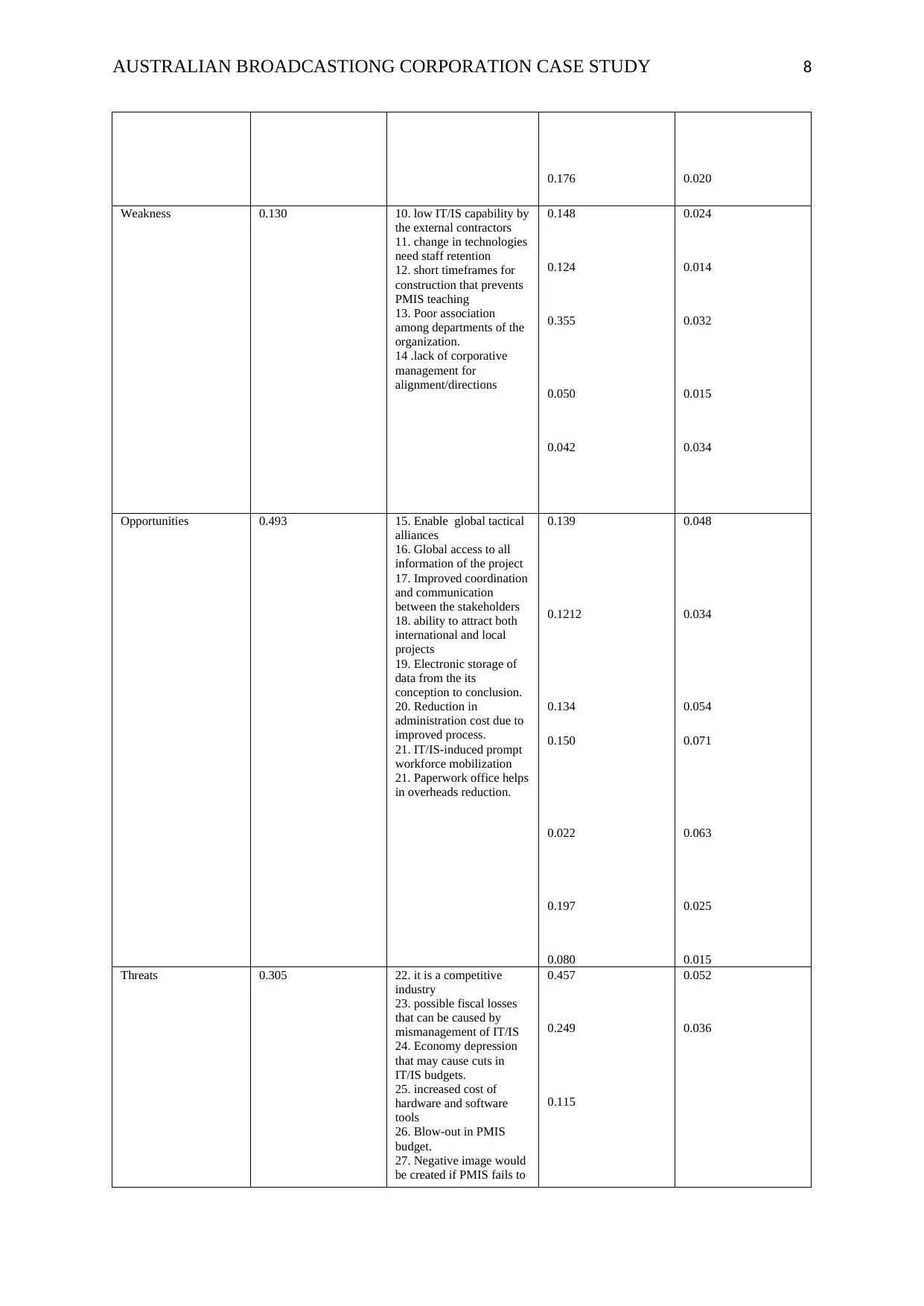
AUSTRALIAN BROADCASTIONG CORPORATION CASE STUDY 8
0.176 0.020
Weakness 0.130 10. low IT/IS capability by
the external contractors
11. change in technologies
need staff retention
12. short timeframes for
construction that prevents
PMIS teaching
13. Poor association
among departments of the
organization.
14 .lack of corporative
management for
alignment/directions
0.148
0.124
0.355
0.050
0.042
0.024
0.014
0.032
0.015
0.034
Opportunities 0.493 15. Enable global tactical
alliances
16. Global access to all
information of the project
17. Improved coordination
and communication
between the stakeholders
18. ability to attract both
international and local
projects
19. Electronic storage of
data from the its
conception to conclusion.
20. Reduction in
administration cost due to
improved process.
21. IT/IS-induced prompt
workforce mobilization
21. Paperwork office helps
in overheads reduction.
0.139
0.1212
0.134
0.150
0.022
0.197
0.080
0.048
0.034
0.054
0.071
0.063
0.025
0.015
Threats 0.305 22. it is a competitive
industry
23. possible fiscal losses
that can be caused by
mismanagement of IT/IS
24. Economy depression
that may cause cuts in
IT/IS budgets.
25. increased cost of
hardware and software
tools
26. Blow-out in PMIS
budget.
27. Negative image would
be created if PMIS fails to
0.457
0.249
0.115
0.052
0.036
0.176 0.020
Weakness 0.130 10. low IT/IS capability by
the external contractors
11. change in technologies
need staff retention
12. short timeframes for
construction that prevents
PMIS teaching
13. Poor association
among departments of the
organization.
14 .lack of corporative
management for
alignment/directions
0.148
0.124
0.355
0.050
0.042
0.024
0.014
0.032
0.015
0.034
Opportunities 0.493 15. Enable global tactical
alliances
16. Global access to all
information of the project
17. Improved coordination
and communication
between the stakeholders
18. ability to attract both
international and local
projects
19. Electronic storage of
data from the its
conception to conclusion.
20. Reduction in
administration cost due to
improved process.
21. IT/IS-induced prompt
workforce mobilization
21. Paperwork office helps
in overheads reduction.
0.139
0.1212
0.134
0.150
0.022
0.197
0.080
0.048
0.034
0.054
0.071
0.063
0.025
0.015
Threats 0.305 22. it is a competitive
industry
23. possible fiscal losses
that can be caused by
mismanagement of IT/IS
24. Economy depression
that may cause cuts in
IT/IS budgets.
25. increased cost of
hardware and software
tools
26. Blow-out in PMIS
budget.
27. Negative image would
be created if PMIS fails to
0.457
0.249
0.115
0.052
0.036
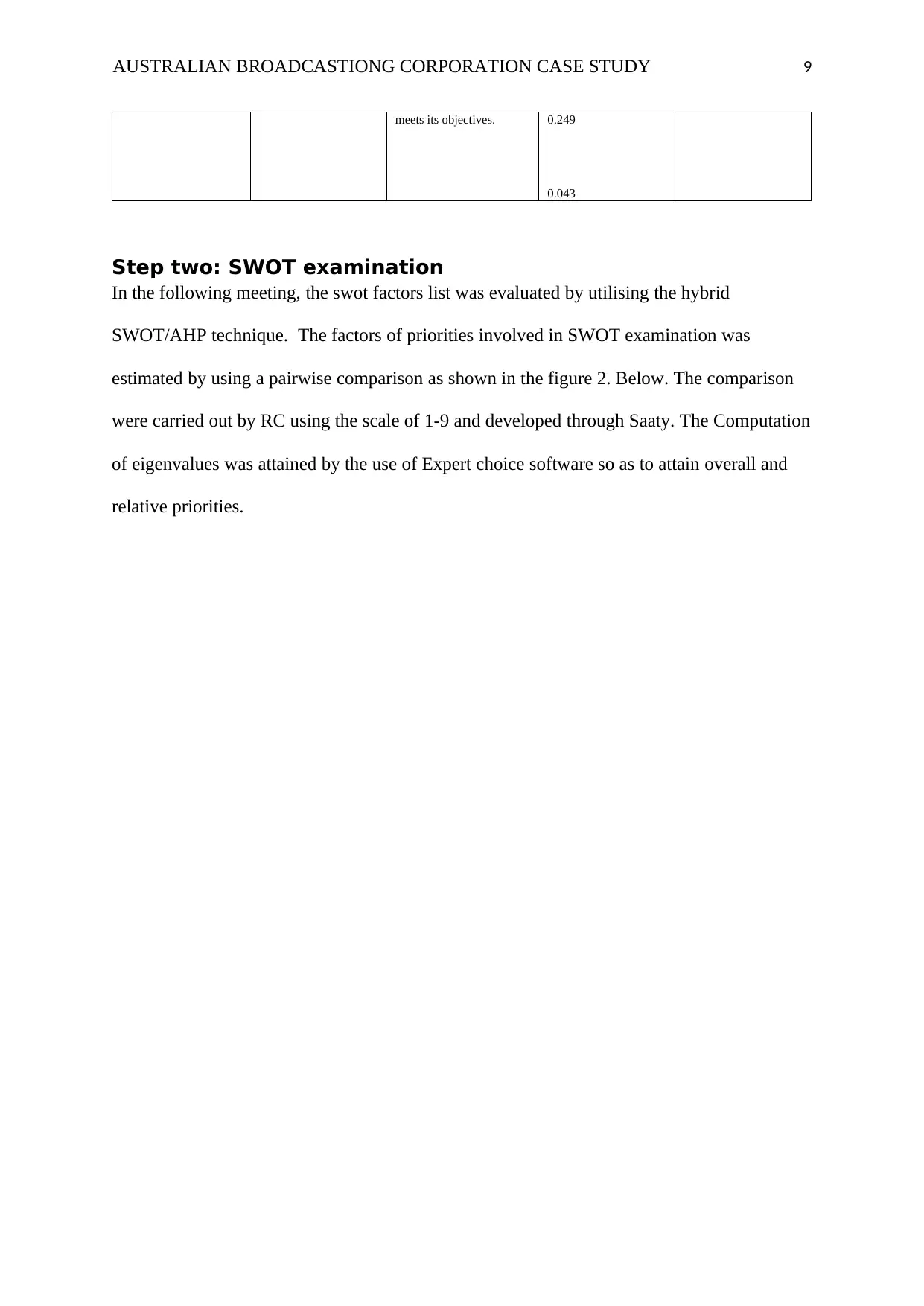
AUSTRALIAN BROADCASTIONG CORPORATION CASE STUDY 9
meets its objectives. 0.249
0.043
Step two: SWOT examination
In the following meeting, the swot factors list was evaluated by utilising the hybrid
SWOT/AHP technique. The factors of priorities involved in SWOT examination was
estimated by using a pairwise comparison as shown in the figure 2. Below. The comparison
were carried out by RC using the scale of 1-9 and developed through Saaty. The Computation
of eigenvalues was attained by the use of Expert choice software so as to attain overall and
relative priorities.
meets its objectives. 0.249
0.043
Step two: SWOT examination
In the following meeting, the swot factors list was evaluated by utilising the hybrid
SWOT/AHP technique. The factors of priorities involved in SWOT examination was
estimated by using a pairwise comparison as shown in the figure 2. Below. The comparison
were carried out by RC using the scale of 1-9 and developed through Saaty. The Computation
of eigenvalues was attained by the use of Expert choice software so as to attain overall and
relative priorities.
⊘ This is a preview!⊘
Do you want full access?
Subscribe today to unlock all pages.

Trusted by 1+ million students worldwide
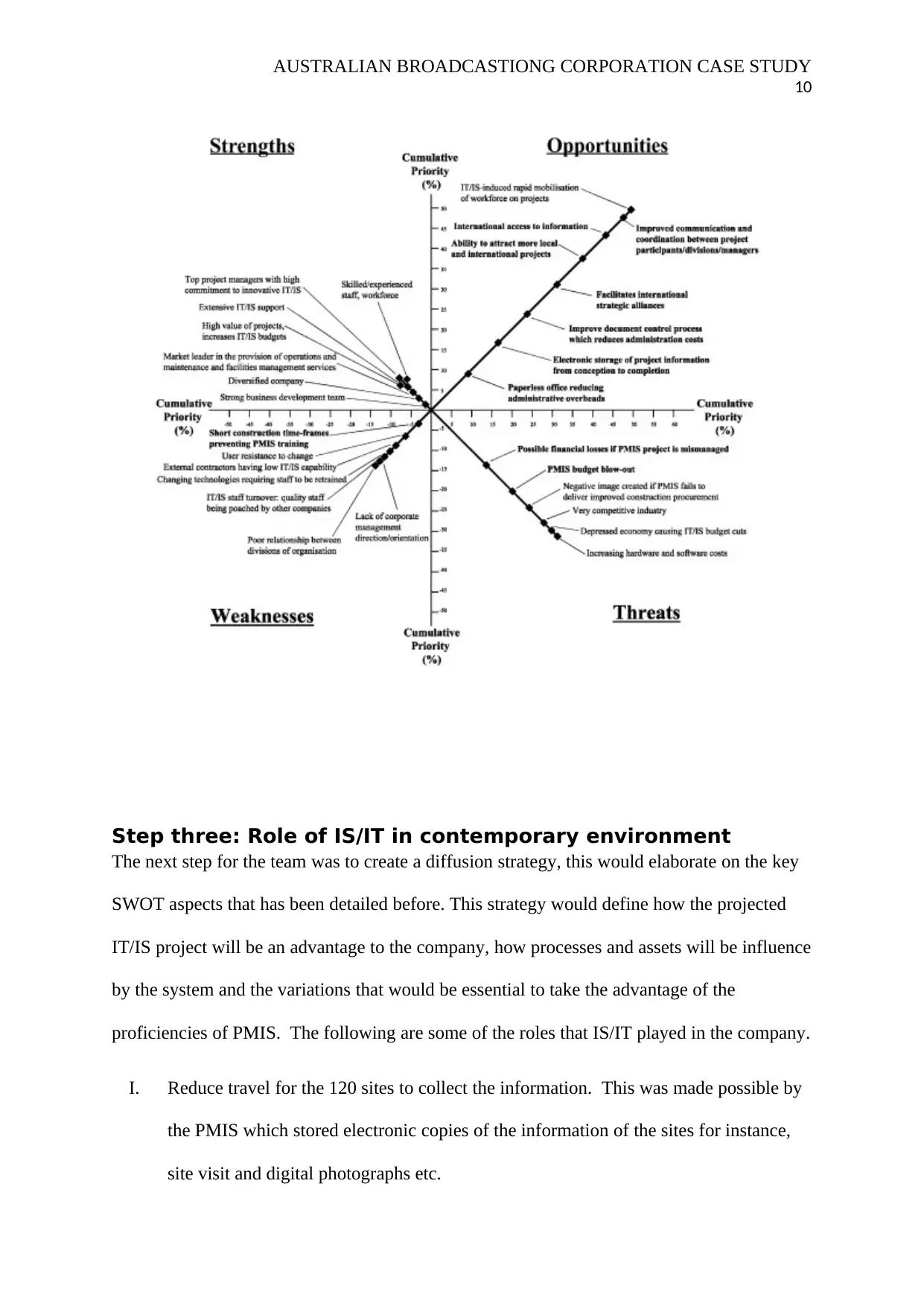
AUSTRALIAN BROADCASTIONG CORPORATION CASE STUDY
10
Step three: Role of IS/IT in contemporary environment
The next step for the team was to create a diffusion strategy, this would elaborate on the key
SWOT aspects that has been detailed before. This strategy would define how the projected
IT/IS project will be an advantage to the company, how processes and assets will be influence
by the system and the variations that would be essential to take the advantage of the
proficiencies of PMIS. The following are some of the roles that IS/IT played in the company.
I. Reduce travel for the 120 sites to collect the information. This was made possible by
the PMIS which stored electronic copies of the information of the sites for instance,
site visit and digital photographs etc.
10
Step three: Role of IS/IT in contemporary environment
The next step for the team was to create a diffusion strategy, this would elaborate on the key
SWOT aspects that has been detailed before. This strategy would define how the projected
IT/IS project will be an advantage to the company, how processes and assets will be influence
by the system and the variations that would be essential to take the advantage of the
proficiencies of PMIS. The following are some of the roles that IS/IT played in the company.
I. Reduce travel for the 120 sites to collect the information. This was made possible by
the PMIS which stored electronic copies of the information of the sites for instance,
site visit and digital photographs etc.
Paraphrase This Document
Need a fresh take? Get an instant paraphrase of this document with our AI Paraphraser
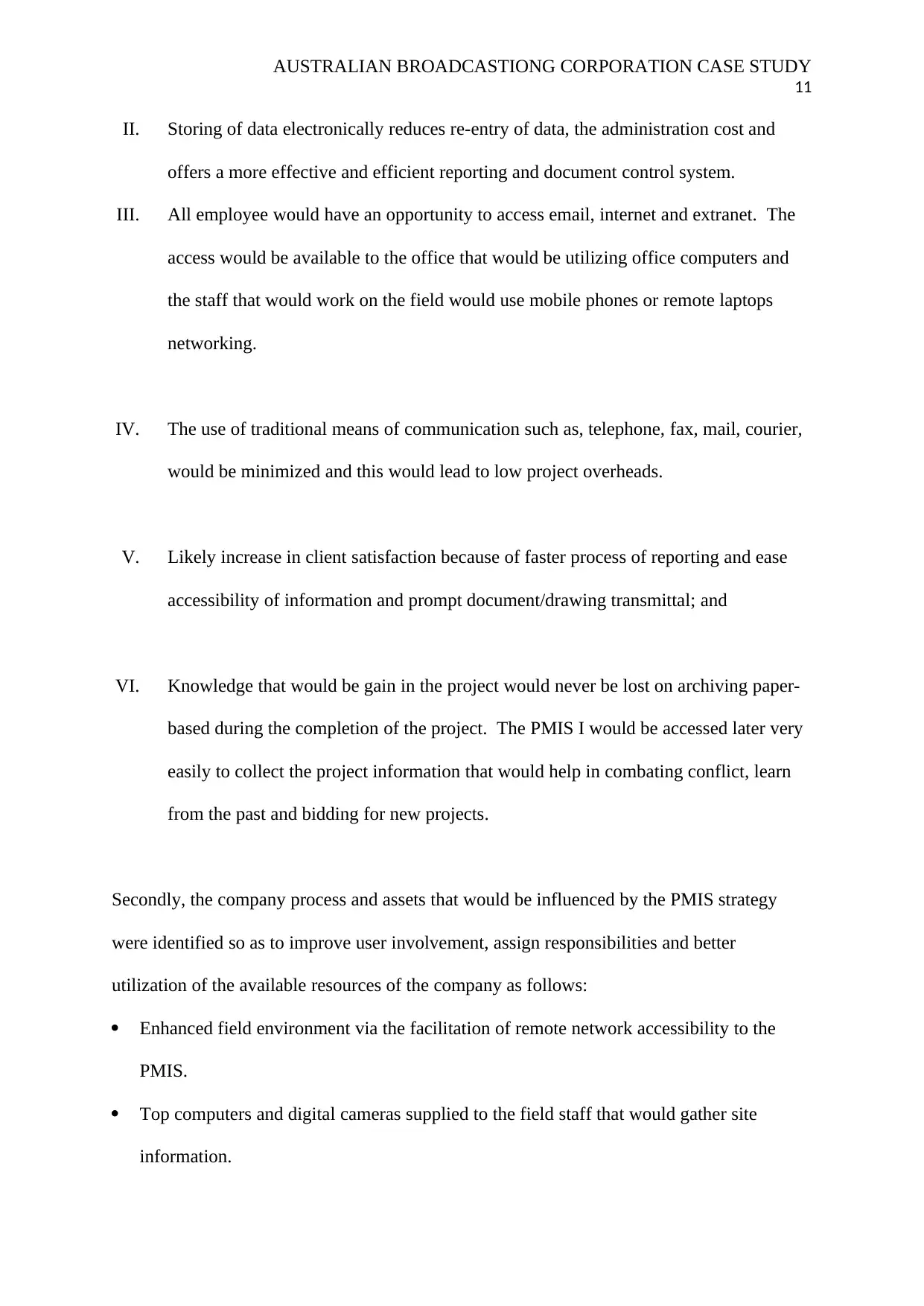
AUSTRALIAN BROADCASTIONG CORPORATION CASE STUDY
11
II. Storing of data electronically reduces re-entry of data, the administration cost and
offers a more effective and efficient reporting and document control system.
III. All employee would have an opportunity to access email, internet and extranet. The
access would be available to the office that would be utilizing office computers and
the staff that would work on the field would use mobile phones or remote laptops
networking.
IV. The use of traditional means of communication such as, telephone, fax, mail, courier,
would be minimized and this would lead to low project overheads.
V. Likely increase in client satisfaction because of faster process of reporting and ease
accessibility of information and prompt document/drawing transmittal; and
VI. Knowledge that would be gain in the project would never be lost on archiving paper-
based during the completion of the project. The PMIS I would be accessed later very
easily to collect the project information that would help in combating conflict, learn
from the past and bidding for new projects.
Secondly, the company process and assets that would be influenced by the PMIS strategy
were identified so as to improve user involvement, assign responsibilities and better
utilization of the available resources of the company as follows:
Enhanced field environment via the facilitation of remote network accessibility to the
PMIS.
Top computers and digital cameras supplied to the field staff that would gather site
information.
11
II. Storing of data electronically reduces re-entry of data, the administration cost and
offers a more effective and efficient reporting and document control system.
III. All employee would have an opportunity to access email, internet and extranet. The
access would be available to the office that would be utilizing office computers and
the staff that would work on the field would use mobile phones or remote laptops
networking.
IV. The use of traditional means of communication such as, telephone, fax, mail, courier,
would be minimized and this would lead to low project overheads.
V. Likely increase in client satisfaction because of faster process of reporting and ease
accessibility of information and prompt document/drawing transmittal; and
VI. Knowledge that would be gain in the project would never be lost on archiving paper-
based during the completion of the project. The PMIS I would be accessed later very
easily to collect the project information that would help in combating conflict, learn
from the past and bidding for new projects.
Secondly, the company process and assets that would be influenced by the PMIS strategy
were identified so as to improve user involvement, assign responsibilities and better
utilization of the available resources of the company as follows:
Enhanced field environment via the facilitation of remote network accessibility to the
PMIS.
Top computers and digital cameras supplied to the field staff that would gather site
information.
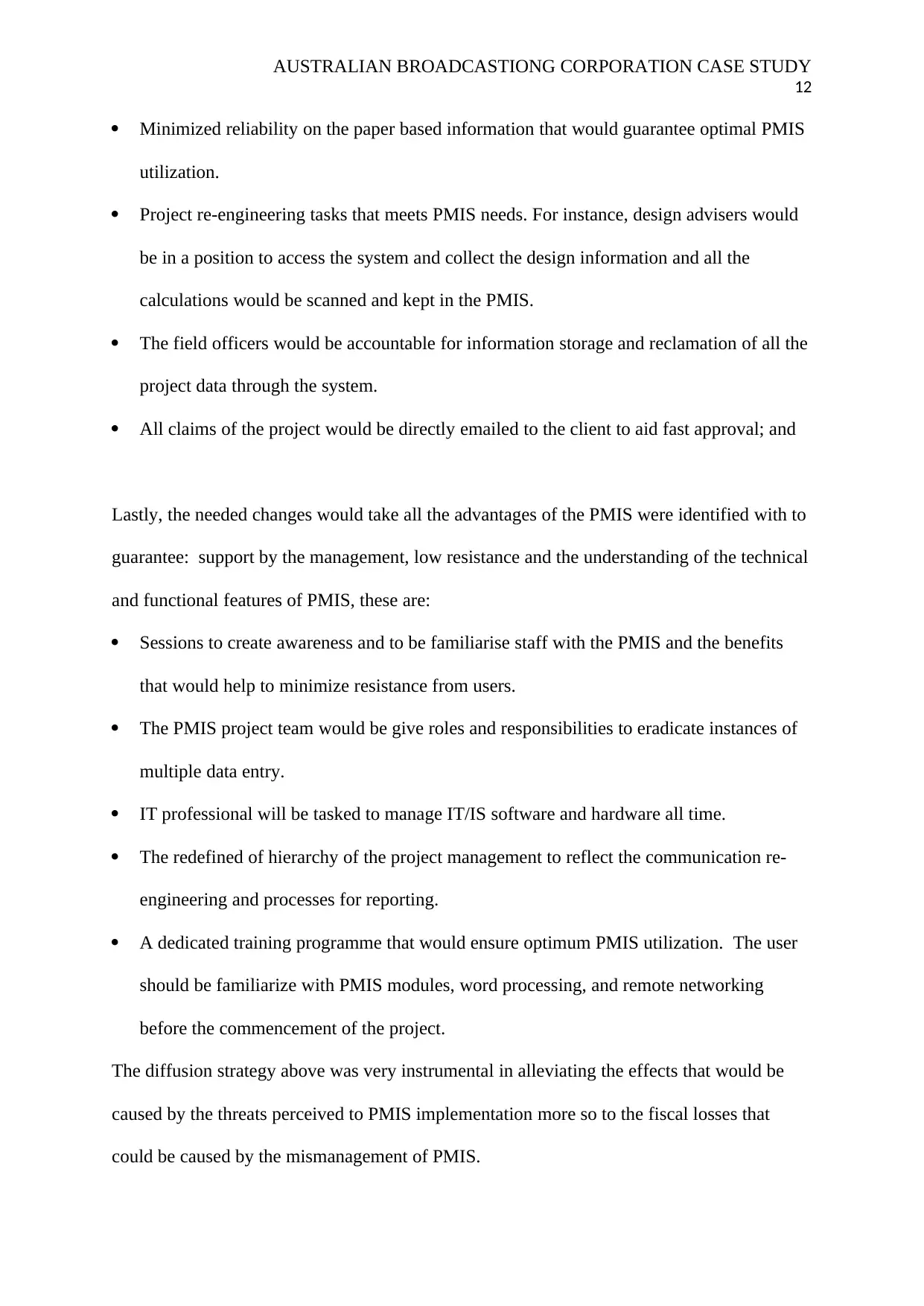
AUSTRALIAN BROADCASTIONG CORPORATION CASE STUDY
12
Minimized reliability on the paper based information that would guarantee optimal PMIS
utilization.
Project re-engineering tasks that meets PMIS needs. For instance, design advisers would
be in a position to access the system and collect the design information and all the
calculations would be scanned and kept in the PMIS.
The field officers would be accountable for information storage and reclamation of all the
project data through the system.
All claims of the project would be directly emailed to the client to aid fast approval; and
Lastly, the needed changes would take all the advantages of the PMIS were identified with to
guarantee: support by the management, low resistance and the understanding of the technical
and functional features of PMIS, these are:
Sessions to create awareness and to be familiarise staff with the PMIS and the benefits
that would help to minimize resistance from users.
The PMIS project team would be give roles and responsibilities to eradicate instances of
multiple data entry.
IT professional will be tasked to manage IT/IS software and hardware all time.
The redefined of hierarchy of the project management to reflect the communication re-
engineering and processes for reporting.
A dedicated training programme that would ensure optimum PMIS utilization. The user
should be familiarize with PMIS modules, word processing, and remote networking
before the commencement of the project.
The diffusion strategy above was very instrumental in alleviating the effects that would be
caused by the threats perceived to PMIS implementation more so to the fiscal losses that
could be caused by the mismanagement of PMIS.
12
Minimized reliability on the paper based information that would guarantee optimal PMIS
utilization.
Project re-engineering tasks that meets PMIS needs. For instance, design advisers would
be in a position to access the system and collect the design information and all the
calculations would be scanned and kept in the PMIS.
The field officers would be accountable for information storage and reclamation of all the
project data through the system.
All claims of the project would be directly emailed to the client to aid fast approval; and
Lastly, the needed changes would take all the advantages of the PMIS were identified with to
guarantee: support by the management, low resistance and the understanding of the technical
and functional features of PMIS, these are:
Sessions to create awareness and to be familiarise staff with the PMIS and the benefits
that would help to minimize resistance from users.
The PMIS project team would be give roles and responsibilities to eradicate instances of
multiple data entry.
IT professional will be tasked to manage IT/IS software and hardware all time.
The redefined of hierarchy of the project management to reflect the communication re-
engineering and processes for reporting.
A dedicated training programme that would ensure optimum PMIS utilization. The user
should be familiarize with PMIS modules, word processing, and remote networking
before the commencement of the project.
The diffusion strategy above was very instrumental in alleviating the effects that would be
caused by the threats perceived to PMIS implementation more so to the fiscal losses that
could be caused by the mismanagement of PMIS.
⊘ This is a preview!⊘
Do you want full access?
Subscribe today to unlock all pages.

Trusted by 1+ million students worldwide
1 out of 18
Related Documents
Your All-in-One AI-Powered Toolkit for Academic Success.
+13062052269
info@desklib.com
Available 24*7 on WhatsApp / Email
![[object Object]](/_next/static/media/star-bottom.7253800d.svg)
Unlock your academic potential
Copyright © 2020–2025 A2Z Services. All Rights Reserved. Developed and managed by ZUCOL.





